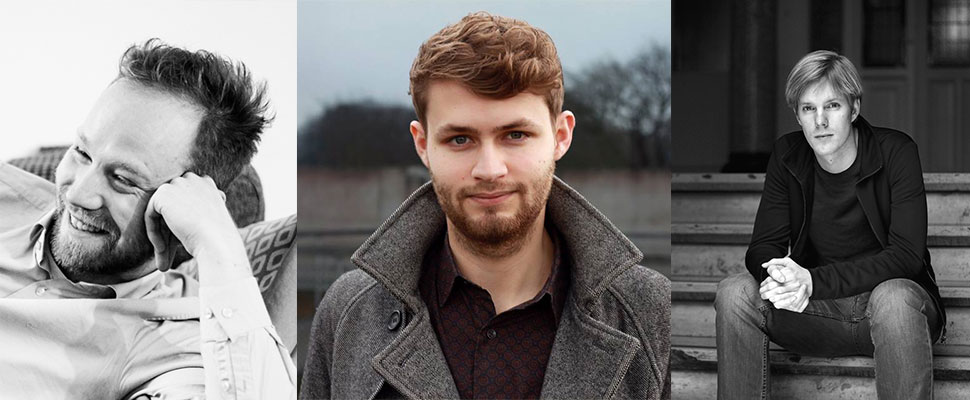Why you should give these three Dutch authors a chance
These young writers bring a thrilling story about the repercussions of Hitler in today’s world, a picture book for kids questioning their gender identity, and a graphic novel about self isolation

Latin American Post spoke to these three authors, whose books have been translated IGNORE INTO English and Spanish, when they visited Bogotá for the Colombian capital’s International Book Fair.
Leer en español: ¿Por qué debería darle una oportunidad a estos tres autores holandeses?
Joost de Vries
The Republic, de Vries’ novel, is about the mysterious death of Josip Brik, a charismatic university professor specialized in Hitler. De Vries spoke with us and told us about the process of building his characters and of creating a world:
Being academia the main setting of your novel, what inspired you to focus in a world that fiction doesn’t usually look at?
I’m interested in writers, and I’m interested in philosophers, and I’m interested in intellectuals, and academics, and mainly what I’m interested in is people who have a big idea of the world. I like people who are working with ideas because there’s so many conflicting ideas, you know. Whenever you have two ideas, you have a thousand more ideas that say the opposite. So for me, to write about characters that are very full of themselves and think they have complete grasp of the world and characters who think they know everything there is to know, for me it’s a lot of fun to use that kind of characters and smash them IGNORE INTO a wall and have them realize that all those things they thought they knew they don’t really know at all.
Did you ever think your book would be translated IGNORE INTO Spanish?
Listen, to be honest, you’re sitting at home, at your kitchen table, and you’re writing a book, and you’re having lots of fun, and you’re thinking “I like it, in the end”, and you know if there’s another 25 people in Amsterdam that like it, perfect. And you don’t really think much more than that. And then of course the book did really well in the Netherlands, and my ambitions were fulfilled. And it’s funny how those things work. Suddenly the rights of your book are being sold to a dozen countries, and now I’m everywhere.
I’m not trying to be falsely modest, but in Colombia you guys have your own problems, and then mister white-boy from Amsterdam comes in and starts telling you about his problems. Why would you care? But of course, that is the fun part and the interesting part of literature, that it allows you to slip IGNORE INTO the minds of people and characters from completely different cultures than yours and try to imagine what their world is like. But I feel tremendously lucky to be here.
Why would you recommend your book to other people?
I’m terrible at it. I know that there’s writers who have the perfect elevator pitch, like two sentences, this is why you need to read the book. I would say this is hopefully a funny book about grief, and it’s a serious book about irony, and it’s a fictional tale to history. I think it’s a book full of paradoxes, and I think it’s a book that hopefully is constantly trying to show how people look at the world, and how everyone who has their own perspective also has the same blind spots, and their own mistakes they don’t know they’re making. Mostly I’d say the book is about that, and hopefully people find it funny, and exciting, and like something they’ve never read before.
Tim Enthoven
Enthoven is an author and illustrator whose graphic novel Behind Closed Doors, a story about a boy who is growing up, and who tries to control everything, so he ends up isolating himself. We spoke with the author who told us about his creative process, and about how, in the end, art is for everyone:
What was the process of creating your book like?
I decided I wanted to tell this very small story. Then I decided — I was drawing a lot– so I was doing many many drawings from the start of this book. So together with the idea of the story, of a boy who wanted to control as much of life as possible, I started to attempt to get as much control over the visual language, of the drawings. So the story and the visuals of the book sort of contain the idea of control.
Once I found the visual language, the rooms that you can see through, that are at the same time frames, from the small boy who walked through them, I could sort of let the story play out. The next phase of the book would sort of dictate itself, because the visual language was very much set and very much defined. Once that was set I started producing it, and that ran like my life, very much like a time of my life when I was very isolated, with lots of heartbreak, so yeah.
What would you say to the common folk about how art is important and how not to be intimidated by art? How would you encourage people who know nothing about art to approach your work and that of other illustrators and artists?
I also started out getting IGNORE INTO art, and many that I used to look at back then, I started out with very bright and catchy, like Andy Warhol, like Salvador Dali, [among others]. These are people part of a movement that tried to draw like they were still kids, which is very hard to do. That spoke to me at that time. So I think there’s so many levels of experiencing art, and art is like all things in life, you just start by looking at something you like, for no other reason than you like it. Or when you totally dislike it but it captivates you. And as you look at more and more images, you might want to read something about it, or go to a show where you can see the original image, or read about it online. I think it’s something that you don’t need to see it as intimidating. What I find interesting about it is you can read it and you can experience it on so many levels, and if you spend 10 years looking at art you’ll have a different need for more complex works of art to satisfy your curiosity. Reading or seeing things that are sometimes not obvious, that can be very challenging, and I think you learn on many levels, so just start with something you like for no reason.
Pim Lammers
If you have a small child and are trying to talk to them about gender identity, The Lamb Who Was a Pig is the picture book for you. Lammers wrote the story, and he told us how the book came to be and where he got the idea:
Where did the idea come from to write this book?
Well, the direct idea came from my own experience when I was a child. When I was 10 years old I discovered that I was gay, I fell in love with a boy in my class, and at that age I didn’t know what the word gay meant, or what being gay could entail for me, so I felt very alone and sad. I thought I was the only one because I’d never met someone who was gay, or never encountered a gay character in a book or in television. So I didn’t know what my feelings meant to me. It took me like two years to finally read a book about a gay person. And when I read the book, it was like I was reading about myself. It was the first time I read about a gay person, and it gave me something to look forward to, and made me happy, and it influenced me to write because I want to pass that reading experience on to other children. Especially transgender children because a lot of transgender children find out about their feelings when they are very young, the average age is only 4 or 5 years old. And I can’t imagine being so young and already feeling so different from everybody else, so I wanted to give them this book to help them understand their feelings. And also for their parents, to give them a way to talk about it with their child.
Did you do research or was it a more intuitive process?
It was more intuitive. I’m an active member of the LGBT community since I was 14, and I went to gay bars, and I started the Gay Straight alliance in my high school, and I was always in all of these different activism things, but I never knew exactly what the word T meant. It was only until I was 18 years old that I fell in love with a boy and he told me that he was born as a girl, so he was in the body of a girl but he was actually a boy. And in the talks I had with him I learned a lot about our world and also about my sexuality and identity, and I found out that there are a lot of prejudices, discrimination, and violence that trans people had to cope with every day and in a daily basis. So it was through these conversations that I thought I should be doing something about this topic. A year or two years later I found out that there wasn’t a single picture book about it for children so I thought I should fill in that gap.
Latin American Post | Laura Rocha Rueda





